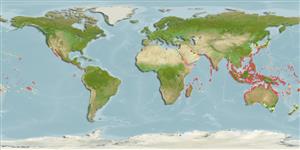Teleostei (teleosts) >
Atheriniformes (Silversides) >
Atherinidae (Silversides) > Atherinomorinae
Etymology: Hypoatherina: Greek, hypo = under + Greek, atherina, the Greek name for the eperlane; 1770 (Ref. 45335).
Eponymy: Coenraad Jacob Temminck (1778–1858) was a Dutch zoologist, illustrator and collector. [...] (Ref. 128868), visit book page.
More on author: Bleeker.
Environment: milieu / climate zone / depth range / distribution range
Ecology
Marine; reef-associated; depth range ? - 8 m (Ref. 86942). Tropical
Indo-Pacific: Red Sea and Delagoa Bay, Mozambique (Ref. 4125) and Persian Gulf (Ref. 68964) to the Cook Islands, north to the Caroline Islands, south to Queensland, Australia.
Size / Weight / Age
Maturity: Lm ? range ? - ? cm
Max length : 12.0 cm TL male/unsexed; (Ref. 4125)
Dorsal spines (total): 6 - 8; Dorsal soft rays (total): 8 - 10; Anal spines: 1; Anal soft rays: 11 - 14. Transparent and blue-green in color, silvery midlateral stripe and abdomen (Ref. 4125). Ascending process of premaxilla moderately long and narrow, lateral process short and wide. Ramus of dentary highly elevated posteriorly. Midlateral band narrow (Ref. 9760). Two rows of pigment spots may be present below lateral band (Ref. 37816).
Usually found in coastal waters and harbors within its range. Important as food for larger commercial fishes (Ref. 9760). Used as bait in the tuna fishery (Ref. 6822).
Life cycle and mating behavior
Maturity | Reproduction | Spawning | Eggs | Fecundity | Larvae
Oviparous, distinct pairing during breeding (Ref. 205).
Ivantsoff, W., 1984. Atherinidae. In W. Fischer and G. Bianchi (eds.) FAO species identification sheets for fishery purposes. Western Indian Ocean fishing area 51. Vol. 1. (Ref. 3302)
IUCN Red List Status (Ref. 130435: Version 2024-1)
Threat to humans
Harmless
Human uses
Fisheries: subsistence fisheries; bait: usually
Tools
Special reports
Download XML
Internet sources
Estimates based on models
Preferred temperature (Ref.
123201): 25 - 29.3, mean 28.4 °C (based on 3184 cells).
Phylogenetic diversity index (Ref.
82804): PD
50 = 0.5001 [Uniqueness, from 0.5 = low to 2.0 = high].
Bayesian length-weight: a=0.00562 (0.00240 - 0.01320), b=3.15 (2.95 - 3.35), in cm total length, based on LWR estimates for this (Sub)family-body shape (Ref.
93245).
Trophic level (Ref.
69278): 3.4 ±0.45 se; based on food items.
Resilience (Ref.
120179): High, minimum population doubling time less than 15 months (Preliminary K or Fecundity.).
Fishing Vulnerability (Ref.
59153): Low vulnerability (10 of 100).
Nutrients (Ref.
124155): Calcium = 114 [61, 210] mg/100g; Iron = 0.793 [0.444, 1.366] mg/100g; Protein = 19.3 [16.9, 21.6] %; Omega3 = 0.124 [0.052, 0.320] g/100g; Selenium = 17.7 [8.6, 44.7] μg/100g; VitaminA = 272 [82, 834] μg/100g; Zinc = 1.73 [1.13, 2.55] mg/100g (wet weight);
